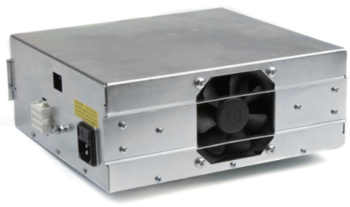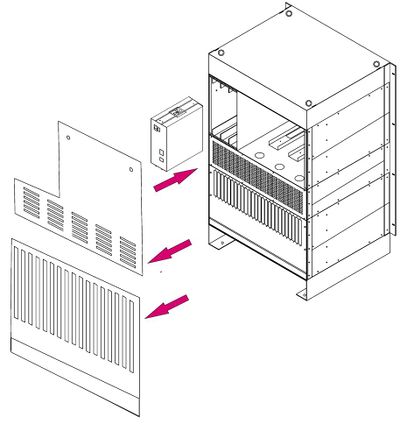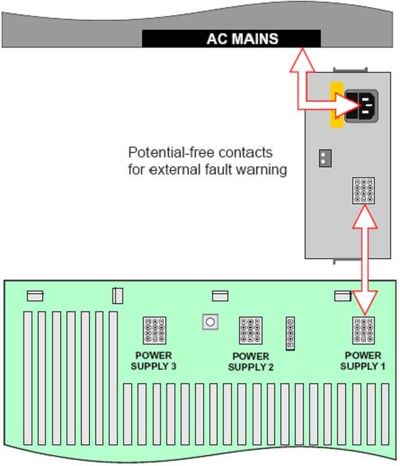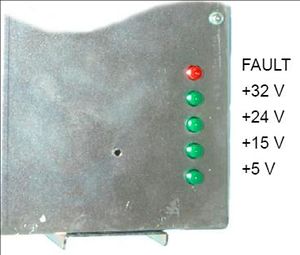APWR Power supply
From Zenitel Wiki
WARNING: This 1009703000 power supply is incompatible with the older 1009701000 supply. Do not put power supplies of different types into the same exchange module.
Contents
Highlights
- Made for AlphaCom 80+, AlphaCom 138, AlphaCom E20/E26 and AlphaCom XE20/XE26
- Provides +5 V, +15 V, +24 V, and +32 V
- Universal voltage input range from 100 to 240 VAC
- Each power supply serves 102 standard stations
- Can be connected in parallel for load sharing and redundancy
- Potential-free alarm output to warn of power failure
- The power supply shuts down if one voltage fails for protection against overheating
- Power factor correction for efficient energy use
- Over voltage and short circuit protected
- Plug connector for DC outputs - no screws
- International safety approvals
- LED indicator per output voltage and fault
- Built-in cooling fan
Additional Documentation
Mounting
- Remove the back covers
- Slide the power supply into the rails in the upper compartment from the rear side
- Fasten the power supply with screws through the front plate
Connection
- Plug the internal power cable to the power supply
- Route the cable through the holes in the main frame
- Connect the cable to a free power connector on the back plane
- Plug the female end of the mains cable into the power supply and the other to the mains outlet in the cabinet’s upper compartment
Indicators
- The green indicators are lit when the voltages are correct.
- The red indicator is lit only if there is a fault in the power. (This indicator is not visible when the front cover is mounted)
Additional information
Potential-free alarm output
The alarm relay is triggered when the power supply is:
- Turned off or without input voltage
- During the startup sequence (5 seconds)
- Overvoltage on all secondary voltages (triggered when approx. 2-3 volt overvoltage on any voltage)
- Undervoltage on all secondary voltages (triggered when approx. 30% drop on any voltage)
- Short circuit current in any secondary voltage
- Mains input lower than 90 VAC or higher than 270 VAC
- Internal temperature higher than 60 degrees C. The red error LED will be flashing. The power supply it self will switch off at 90 degrees C internal temperature. The red error LED will then be steady lit.
Except from the flashing between 60 and 90 degrees, the red LED will follow the relay output.
0V output versus Mains ground
Definition:
- 0V = the output 0V signal
- Mains ground = the chassis/protective ground
The chassis of the PSU 9703 is NOT connected to the 0V output, it is fully isolated. You should measure infinite resistance, at least more that 20 Mohm. There are some decoupling/EMC capacitors that might influence on isolation measurements.
The PSU chassis is connected to the mains ground.
The 0V is connected to chassis (= mains ground) through the backplane of the exchange, which means that in the Exchange chassis and the PSU chassis are connected to the PSU 0V output.
In backplanes of latest revision it is possible to break the connection between 0V and chassis (= mains ground). You then get a fully isolated (almost, there is a 3,3Mohm bleeder resistance between 0V and chassis on the backplane).
Minimum load for the 32V output
The power supply 1009703000 version 01.02 and earlier has minimum load requirement for its 32 volt output. Under operational circumstances this will never be a problem but during commissioning, when no stations are connected this could be noticeable.
Although the PSU is designed with a minimum load requirement, normally this is not critical; the PSU will start up even with no load at all. The only time when the minimum load requirement may become noticeable is when the exchange is switched off and immediately on again after the exchange has been running for some time. In this case if there are any ASLT cards present in the system with no load to the +32V, e.g. no connected intercom station, the PSU may not start up. The proper way to resolve this situation is to make certain that at least 1 intercom station is connected to each ASLT. Waiting a short time until all capacitors are discharged and the internal temperature has gone down a little may appear to be a sufficient remedy, but this does not fulfill the real minimum load requirement.
The minimum load requirements on the other power outputs are sufficiently handled by the presence of the minimum number of cards required to make the AlphaCom E20 and AlphaCom E26 working exchanges.
The minimum load requirement is not applicable as from version 01.03 and higher.




